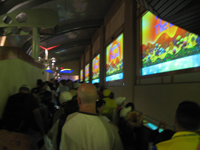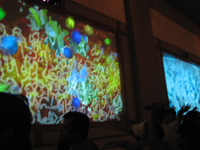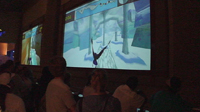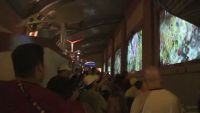Living Landscapes
January 2007 - July 2007Client: PlayMotion / Disney Imagineering
Project Description
The line for the most popular attraction at one of the major theme parks in Orlando can get pretty long. At busy times the wait can exceed two hours! To improve the guest experience, the park wanted to experiment with making the line itself an entertaining experience instead of just a hour wait for a nine minute ride. As a test of this new idea they started with the most popular ride they had (with the most boring line). 
The LineOne particular part of the line is a wide, straight hallway about 150 feet long. PlayMotion was hired to create a series of games for guests to play while they waited in this hall. Along the hall, five 20'x11' projection screens were mounted, each with room for about 50 guests in front of it. With all five screens, we can accommodate up to 250 guests playing simultaneously. With a custom sensor box, we can see the guests and allow them to play several games using their body while standing in place in line.
During the games we show the crowd their outlines. When they move they can recognize themselves and use their outline to play with objects on the screen. Four games were developed for this first round of installation. One game allows guests to use their bodies to form the shape of mountains and hills and build their own landscape. After shaping the land, they can make a gesture like a growing tree to sprout plants, flowers, and trees on the land they created. 
People Playing BlobsIn another game, each of the five screens has a unique landscape such as a beach, a desert, a snowy mountain, a jungle, or a forest. Each landscape has its own unique object to play with such as beach balls, tumbleweeds, snowballs, and more. Not only can the guests pass these ball-like objects back and forth on their own screen, but they can also pass them down the hall onto other screens, tossing snowballs into the desert, for instance. Another game has blobs of paint that guests can pop to reveal interesting and beautiful pictures. Finally, the most popular game is one where the crowd in front of each screen is a team that must work together to steer a bird through a twisty river canyon. By leaning left and right the group must avoid obstacles in order to beat the other teams in a race up the river.
My Role

Lean to SteerFor this project, there were several programmers on the team and so I was primarily responsible for the racing game. Although it feels like a simple game, I spent a lot of time testing and improving the way in which the leaning would control the bird. We had to find a delicate balance of not so hard that people would give up and not so easy that it wouldn't be fun and challenging. The most important thing we learned from our guest testing, besides the course and navigation improvements, was the important of training. Even though the directions were simple, if the guests weren't paying attention they might miss them. After I put in a carefully planned introduction and training course with voice overs we saw a great improvement in how well people did at the game and also in how much fun they had playing.
In addition to that game, my biggest responsibility was for the software architecture that synchronized and managed all the games. Each of the five screens was run by a separate computer. It was important that the same game be running on all machines and that they start at the same time. We had a sixth computer that coordinated the other five. I designed the software that ran on that computer, telling the others what game to start when, and also the software that listened to that server and started the appropriate game at the right time. Besides just launching the games, though, it was also responsible for showing a slide show between games and making sure all the games continued to run properly. The theme park is open about 12 hours a day, 365 days a year and they insisted that our games needed work at least 95% of the time without failure. With that constraint, the software that monitors each game and each machine is extremely important. I designed it in such a way that the monitoring software can not only detect immediately when a problem has occurred, but most of the time it can fix the problem without manual intervention. 
Operator Control CenterDue to this, we were able to leave the games unattended even on the first day it was open to the public, though there were still a few bugs in some of the games, the system stayed operational all day on its own.
Finally, I had to design and build a simple touch panel interface for the ride operators to be able to control our games. They needed to be able to start up the system in the morning, choose when to run games or when to let the system run the games on its own, monitor the status of all five screens, and shut it down at the end of the day. In addition, I built in the ability to choose how many screens were active so that games weren't running on screens where no one was playing at times when the line was not completely full.
Videos
 Playing in Line |
 Air Race |















